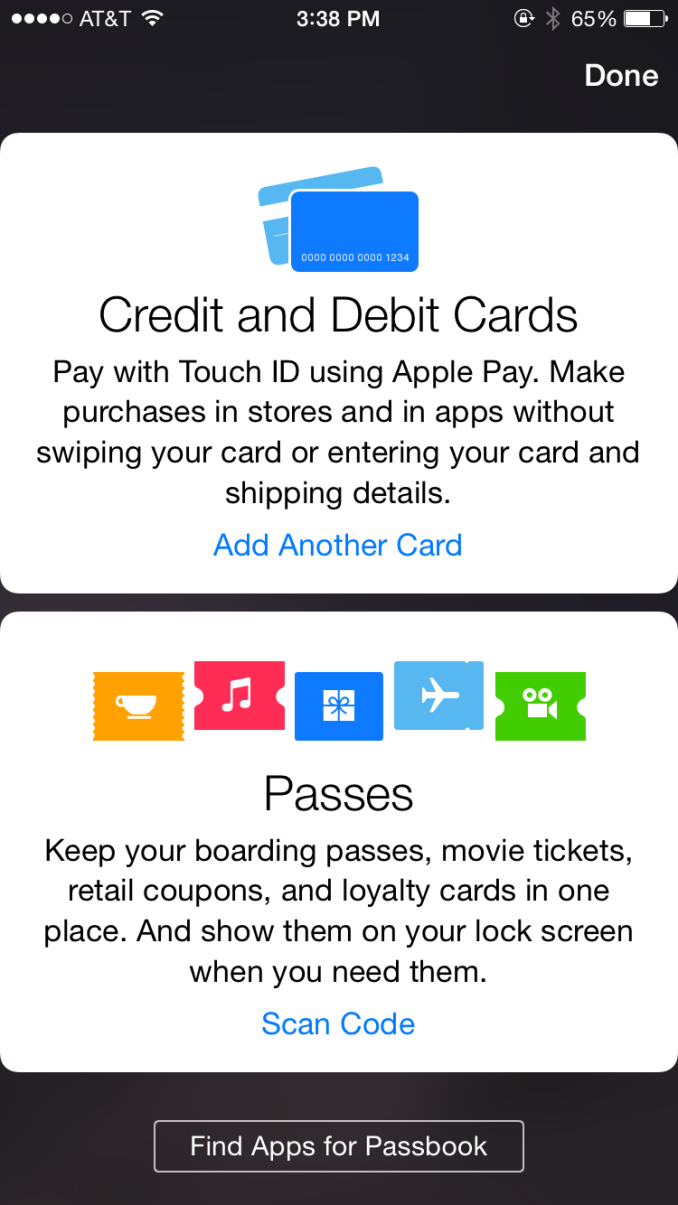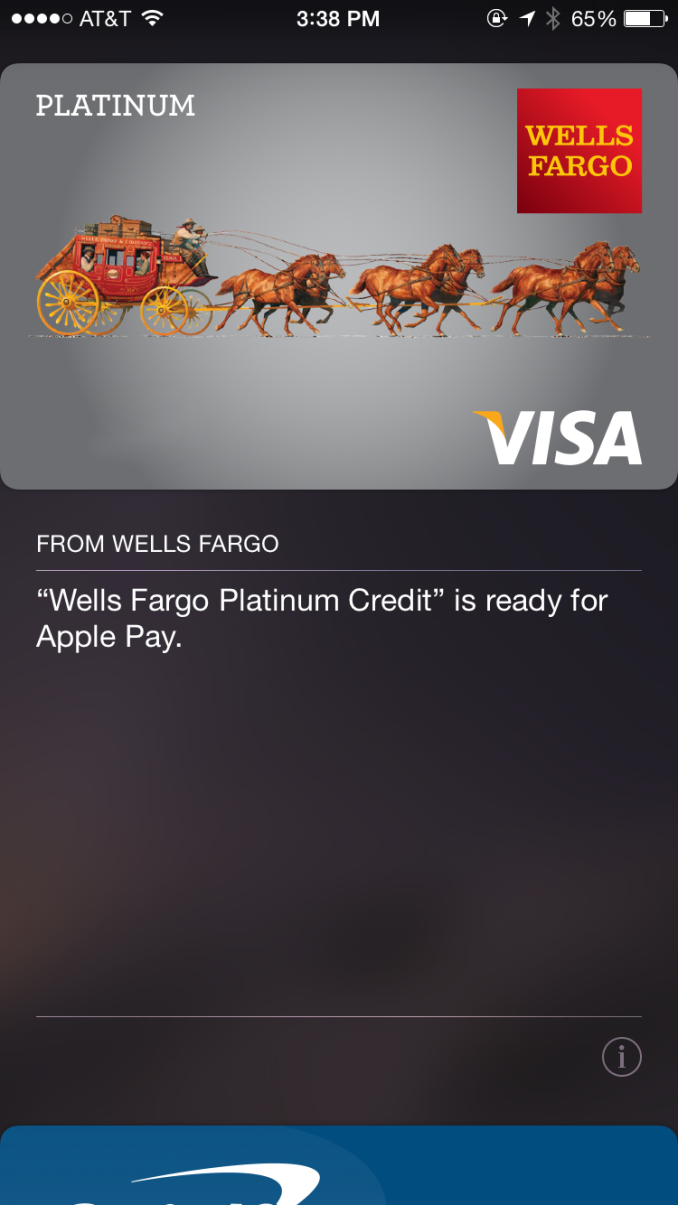A Look At OS X Yosemite And iOS 8.1
by Brandon Chester on October 27, 2014 8:00 AM ESTApple's Foray Into Payments
Apple has made two announcements this year that show an expansion into areas outside of the technology industry. The first was Apple Watch, which is most definitely a technology product but looks positioned against the current premium watch industry just as much as against current smartwatches on the market. The second was Apple's foray into the payment industry, Apple Pay. While Apple Watch won't be around until next year, Apple Pay is here right now with one caveat. Apple Pay currently only works in the United States, or more specifically, only with a credit card issued by a United States bank. However, the service will eventually be expanded to support cards issued by banks in other countries.
How Apple pay works is fairly straightforward, that's the entire point of it. If the region on your device is set to the United States, the passbook app will contain a card that allows you to add a credit or debit card. You can then either type your info in, or use your camera to get the information from the card. Once the card is verified by your bank, you will have a card that appears in passbook and you're ready to start using Apple Pay. From the user's perspective, Apple Pay is simple and easy to use. But what goes on behind the scenes to keep everything secure can be quite complicated.
Security
The first thing to know is that your credit card information is never stored on the phone. Upon adding a credit card, the information is encrypted and sent to the appropriate issuing bank which confirms that the card is valid. A token is then sent back to the iPhone and stored in the secure element, which is essentially just an internal smart card chip. This token, not your credit card number, is what is used during payments. Apple's marketing and technical material refers to it as a Device Account Number. The token itself resembles a credit card number, but the only similarity between it and your card is the 4 digits on the end.
The use of tokens is where much of the security of Apple Pay comes from. By removing the actual credit card number from the equation, the merchant you're paying never gets to see your credit card number, security code, or your name. The token presumably is also only linked to the actual credit card via some database held by the bank, rather than some sort of equation that could be reverse engineered. This means that even in the event where a merchant is hacked and your token number shows up, it is entirely useless because it does not function as a credit card and is tied to the iPhone it was used on.
Beyond the overarching security, there's additional security at the time of payment. It begins with the use of Touch ID for authorizing payments. Although Touch ID launched with the iPhone 5s which does not have the necessary NFC hardware to use Apple Pay, I believe that this sort of service was the original goal when Touch ID was first being created. Paying with Apple Pay requires using Touch ID to verify your fingerprint. This prevents anyone from making purchases using your iPhone if it is lost or stolen.
One thing to note is that Apple Pay is not just a service for making purchases in stores. It also works for making purchases at online retailers than integrate it into their applications. All the security features that I've described apply to both in-store and online purchases, so there's no compromises on either side.
Going Forward
Making Apple Pay successful is going to take a lot of work on both Apple's part and on the part of retailers. Currently the service only works with cards from US banks, leaving out the rest of the world. Apple needs to expand the service much quicker than competitors have done so with theirs. For example, Google Wallet remains a US only service over 3 years after its initial launch. Apple Pay is not going to achieve success if it ends up in the same situation. Apple has given no timeframe for expansion to other countries, but if the iPhone 6 and 6 Plus get replaced by newer models before Apple Pay expands outside the US it will be a worrisome situation.
Apple also needs to convince retailers to support the service. The list of supported merchants on the Apple Pay section of their website has grown since its initial launch, and if Apple Pay is ever going to be a viable way to make everyday purchases that list needs to continue to grow. Work by banks to increase adoption of NFC capable terminals will also speed up this process, as Apple Pay works with existing NFC enabled checkouts. Apple also faces resistance from retailers that are partnered with other payment systems. Recently there have been reports that merchants who support the CurrentC mobile payment standard are disabling NFC on the payment terminals in their stores to block Apple Pay. I don't believe this will be an issue in the long term because consumers will realize when companies are prioritizing their own agenda over the customer's experience and they'll go to other retailers. If Walmart won't support Apple Pay and a customer wants to use it, they'll just go to Target instead.
As someone who doesn't live in the United States, I'm hopeful that the service will expand to Canada before this iPhone becomes obsolete. There are many obstacles in the way, but Apple appears to have put more effort into working with banks and merchants to get the service off the ground than any of the other mobile payment services we have today. How things play out will only be revealed with time.












173 Comments
View All Comments
p_giguere1 - Monday, October 27, 2014 - link
I think the main point of this article is to present an overview of what's new in Yosemite compared to its predecessor Mavericks.The negatives you would like to see mentioned are not new to Yosemite, they're limitations of the whole OS X platform when you put it next to other OSes.
It seems this article did not aim to analyze the whole OS X platform and whether it's a good OS choice, but rather tell existing OS X users what are the new features they'll get by upgrading to Yosemite.
I understand that may not be the kind of article you would have preferred, but the fact people make a big deal out of this to the point of attacking Anandtech makes the the complains hard to take seriously IMO. I feel some of the people calling Anandtech biased are not very objective themselves, and would rather see an article pointing the downsides of OS X just to validate their own decision of sticking with another OS, even though it would deviate from the original point of the article.
TEAMSWITCHER - Monday, October 27, 2014 - link
It's you. Apple is THE premiere ecosystem provider, with smart phones, tablets, laptops, and desktops. There simply is no other manufacturer that comes close to the breadth of devices they sell...with the software that ties them all together....and a breadth of applications to make the experience worthwhile.If Anandtech didn't cover topics like this...I would remove my bookmark to their site.
at80eighty - Monday, October 27, 2014 - link
mmm. tasty tasty kool-aidsolipsism - Monday, October 27, 2014 - link
You've piqued my interest. If saying that Apple's OSes are the best for a unified ecosystem between disparate device categories has you pull out a Kool-Aid comment then what is inarguably better?I personally know of nothing and with Yosemite and iOS 8 ones ability to make a smooth transition between devices from one moment to the next without altering your workflow has been vastly improved. So, please, elucidate as to what combinations of desktop and mobile OSes are even more user friendly and efficient to setup and use?
ppi - Tuesday, October 28, 2014 - link
Well, Apple is certainly step ahead of everyone else in terms of integrating together devices made by Apple.The trouble comes when you try to plug in something else. Or plug an idevice to non-Mac (/waves to worst application on Windows, i.e. iTunes). And this OS X update apparently does little to nothing to improve in this direction.
So going Apple is basically all or nothing decision.
retrospooty - Monday, October 27, 2014 - link
LOL. Now THAT is funny.invinciblegod - Monday, October 27, 2014 - link
Good now you can leave since apparently anything positive about Apple is a corruption in journalism. Doesn't matter if it's any good or not because it is crapple and must be horrible and the only way they can have any fair coverage is if the site says it was made by the devil and should be destroyed for it's pretentiousness. Since you and people like you say the same things about every site on the internet that has positive apple coverage in it, I can only assume you are an apple hater for no reason other than the fact that they are annoying in their locking down on stuff or you hate steve jobs.sjprg2 - Monday, October 27, 2014 - link
BOTH!michael2k - Monday, October 27, 2014 - link
It's just you. It's written by a Mac user, so it will be biased towards other Mac users. If you don't particularly care about iOS and Macs then this review will be like reading about the new Mustang when you happen to not care about cars.Brandon Chester - Tuesday, October 28, 2014 - link
For the record I don't own a Mac